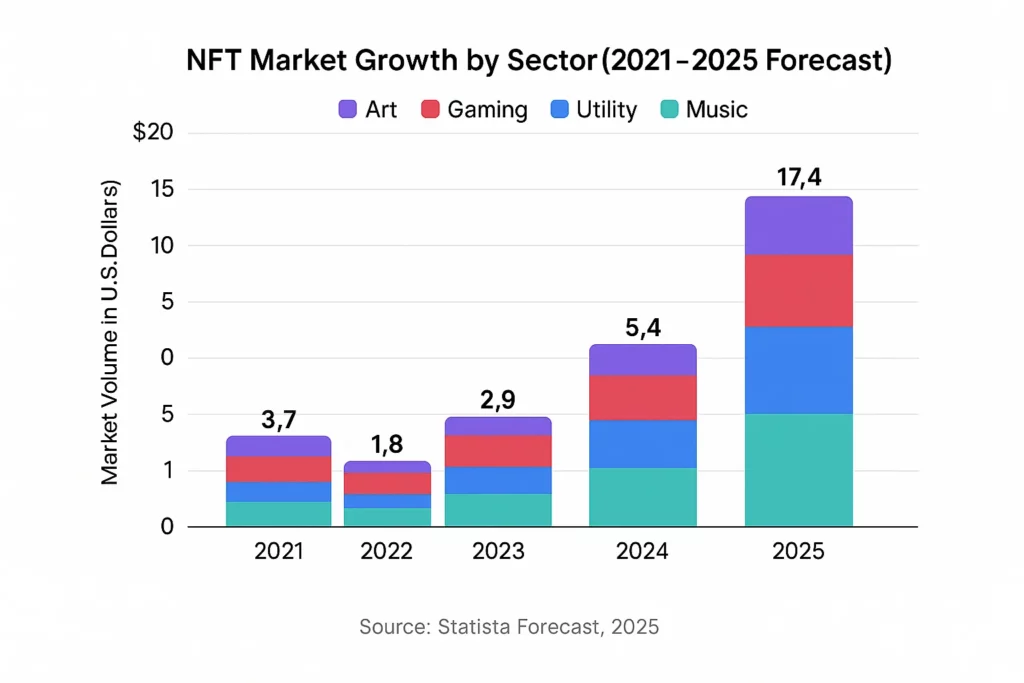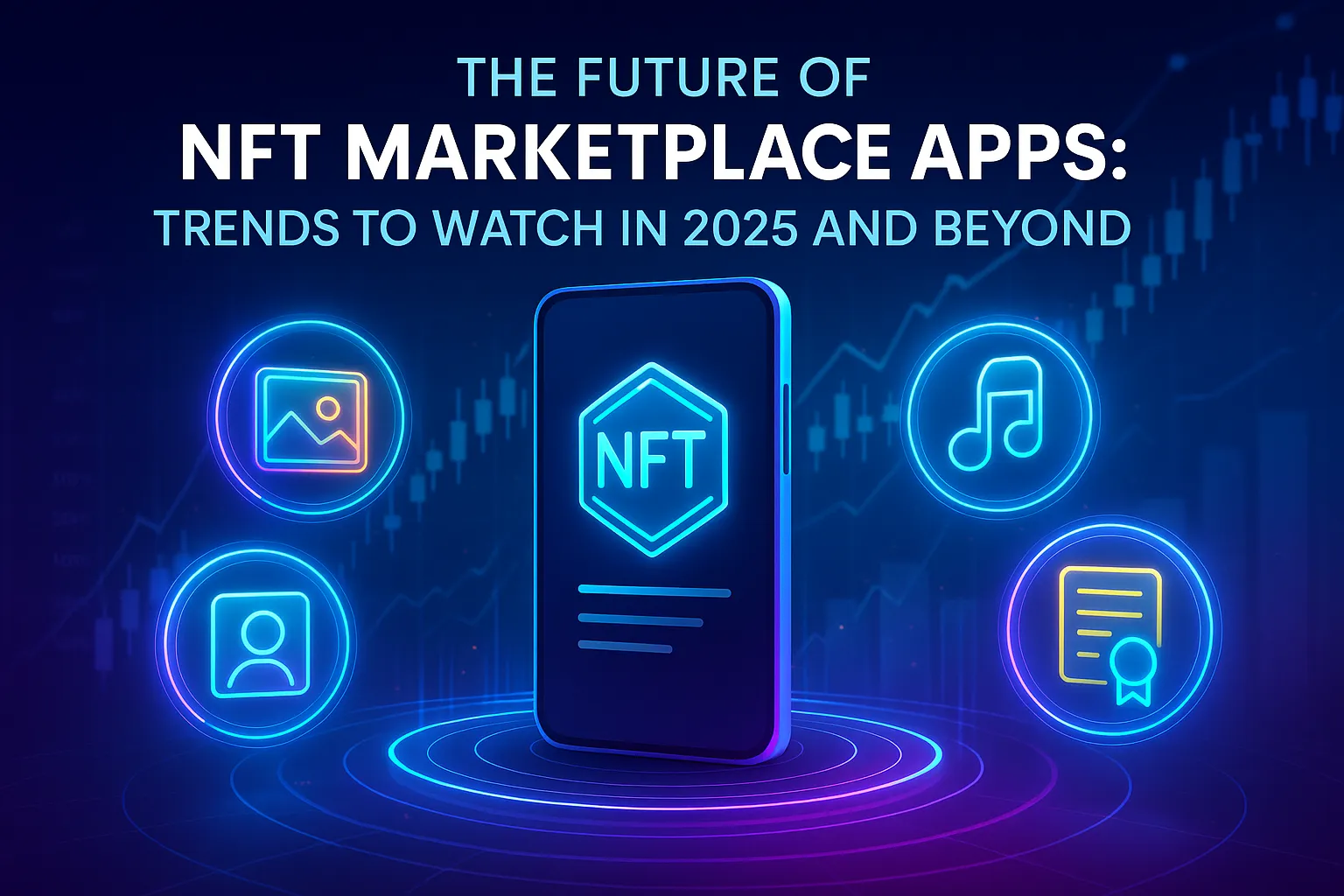Ever felt like you blinked and the internet started selling digital monkeys for millions? Yeah, same. The NFT boom might’ve cooled off from its peak frenzy, but don’t mistake a market maturing for one that’s disappearing. In fact, 2025 is shaping up to be a rebirth — a smarter, more utility-driven, and creator-first evolution of NFT marketplaces.
Whether you’re an artist sick of middlemen, a startup founder ready to ride the digital ownership wave, or a tech dreamer hunting the next OpenSea, the winds of change are blowing hard. From gaming assets to tokenized real estate, the way we interact with NFTs is getting a full-on makeover.
And guess what? If building your own NFT marketplace app is on your vision board, Miracuves is the tech genie you’ve been looking for. NFT Development Solutions
Market Snapshot: NFTs Aren’t Dead, They’re Leveling Up
NFT transaction volumes dropped over the past year, but don’t let that fool you. According to Statista, the NFT market size is projected to reach $3.2 billion by the end of 2025, with gaming, fashion, and digital identity leading the pack. What we’re seeing is a shift from speculative hype to practical use.

Big NFT Marketplace Players (and What They Teach Us)
Here’s a quick whistle-stop tour of the top platforms setting the tone — and what makes each of them worth watching in 2025:
OpenSea
The OG of NFT marketplaces, OpenSea supports multiple blockchains and a wide range of digital assets. But its slow pace of innovation has opened the door to challengers.
Rarible
Community-owned, multi-chain, and creator-friendly. Rarible’s DAO model points to a future where users shape the platform, not just consume it.
Foundation
Art-focused and high-brow, Foundation combines exclusivity with design-led UX. Think NFT meets art gallery vibes.
Blur
Fast, trader-focused, and made for pros. Blur’s rise shows that serious NFT investors want speed, analytics, and flexibility.
Zora
Built on optimism and creator tools. Zora is doubling down on low-gas minting and event-based NFTs (concert tickets, IRL perks).
Catalog
A SoundCloud for music NFTs. Catalog represents how vertical-specific marketplaces (music, fashion, etc.) are the future.
Read more: What is MetaMask Wallet App and How Does It Work?
2025 Trends Shaping the Future of NFT Marketplaces
1. AI + NFTs = Intelligent Ownership
Imagine minting dynamic NFTs that evolve based on your behavior. AI-generated art is already hot, but AI-powered NFT logic (like changing traits over time) is just beginning.
2. Real-World Utility > JPEGs
NFTs are moving beyond pretty pictures. In 2025, expect marketplaces to focus on real-world use cases:
- Ticketing (sports, concerts)
- Loyalty rewards (airlines, brands)
- Proof of ownership (real estate, education certificates)
This isn’t hype — brands like Starbucks and Nike are already testing Web3 loyalty programs.
3. Multichain & Gasless Experiences
New users don’t care about chain wars. They want smooth onboarding. Marketplaces will increasingly support:
- Cross-chain minting
- Gasless transactions (via Layer 2s like Polygon)
- Wallet-free logins (email/social-based)
4. Creator-Centric Monetization Tools
In 2025, creators are demanding tools that go beyond minting. They want:
- Subscription-based NFT access
- Dynamic royalties (based on engagement)
- Launchpad features for new drops
Platforms like Rarible and Zora are already rolling this out, but expect all new marketplaces to prioritize creator revenue flows.
5. Gamified Marketplaces
Gamification isn’t just for players — it’s for users too. From XP points for collectors to loot box-style drops, gamification helps:
- Boost engagement
- Retain users
- Encourage frequent trading
6. Social Features Will Be Native
The days of buying NFTs in isolation are over. In 2025, expect marketplaces to feel more like social networks with:
- Follower systems
- Likes, comments, and share buttons
- Live mint feed and trending tabs
This also opens up new monetization: influencers and viral mints.
Why NFT App Founders Need to Think Beyond the Clone
Sure, you could launch “just another” NFT marketplace — but in 2025, that won’t cut it. What users crave is differentiation + simplicity + utility. That’s why startups are opting for white-label NFT solutions that they can rapidly customize.
Want to build an OpenSea Clone, Rarible-style DAO platform, or a niche NFT app for musicians or gamers? Start fast, iterate smart, and keep room for real innovation.
Read more: How to Start a NFT Marketplace Platform Business
Conclusion
NFTs aren’t dying. They’re transforming — from collectible chaos to tools of real-world value, community, and creativity. Whether you’re a creator-led startup or a VC-backed tech team, 2025 offers a chance to reshape how ownership works online.
At Miracuves, we help innovators launch high-performance app clones that are fast, scalable, and monetization-ready. Ready to turn your idea into reality? Let’s build together.
FAQs
Q1. What is an NFT marketplace app?
It’s a digital platform that allows users to mint, buy, sell, or trade NFTs — non-fungible tokens — which can represent art, music, gaming assets, or even real estate.
Q2. Can I build a clone of OpenSea or Rarible?
Absolutely. Miracuves offers clone development services that replicate the core features and let you customize with your own branding and add-ons.
Q3. How do NFT marketplaces make money?
Most make revenue through transaction fees, minting fees, premium listings, or exclusive drops.
Q4. What blockchain should I choose for my NFT marketplace?
It depends on your goals. Ethereum is the most popular, but Polygon, Solana, and BNB Chain offer lower fees and faster speeds.
Q5. Are there legal concerns with NFTs in 2025?
Yes — IP rights, royalty enforcement, and KYC compliance are hot-button issues. Partner with a legal advisor and ensure your platform stays compliant.
Q6. How long does it take to build an NFT marketplace app?
With a white-label solution from Miracuves, it can take just a few weeks to launch a fully functional MVP.
Related Articles:
- How to Develop a Website Builder SaaS Platform App
- How to Build a Cryptocurrency App like Gemini from Scratch
- How to Build an App Like Paxful: Developer Insights from Scratch
- The Future of Blockchain: Top 10 Industries Ready for Transformation
- Most Profitable Home Services Marketplace Apps to Launch in 2025








